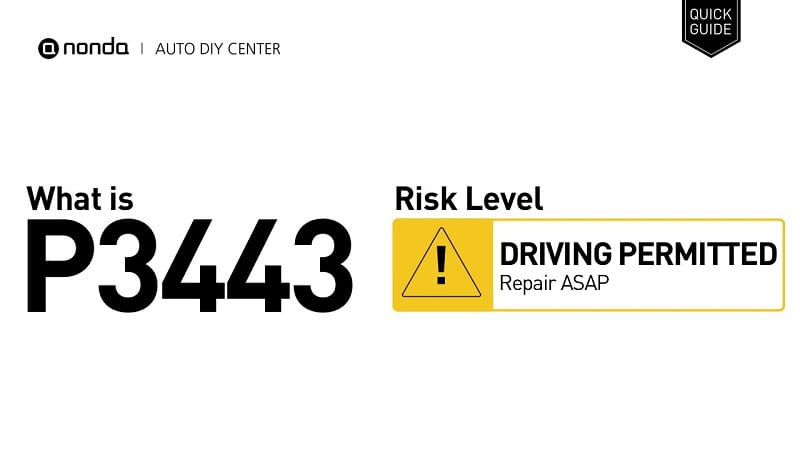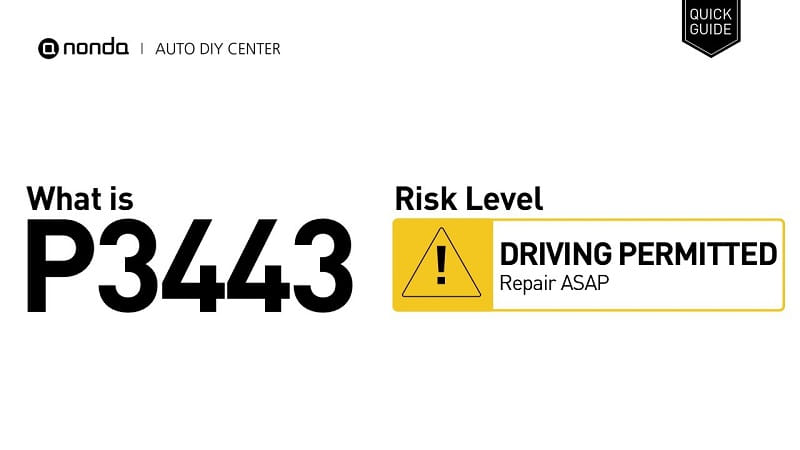This post contains affiliate links. This means I will make a commission at no extra cost to you should you click through and make a purchase [ “As an Amazon Associate, I earn from qualifying purchases.” ]. Read the full disclosure here.
P3443 Cylinder 6 Deactivation/Intake Valve Control Circuit Low GuideMechanic.Com Modern engines are becoming increasingly sophisticated, using advanced technologies to strike a balance between performance and fuel efficiency.
One of the key features used by many automakers—especially in V6 and V8 engines—is cylinder deactivation, also known as Active Fuel Management (AFM) or Displacement on Demand (DoD).
This system allows the engine to deactivate selected cylinders during light-load conditions to improve fuel economy. However, these systems rely on complex electrical and hydraulic mechanisms to function correctly.
When an issue arises in one of these circuits, the engine’s computer system (ECM/PCM) generates a Diagnostic Trouble Code (DTC). One such code is P3443 – Cylinder 6 Deactivation/Intake Valve Control Circuit Low.
In this article, we’ll break down what this code means, its symptoms, causes, diagnostic process, and how to repair it.
See Also: P3442 Cylinder 6 Deactivation/Intake Valve Control Circuit Performance
P3443 Cylinder 6 Deactivation/Intake Valve Control Circuit Low
What Is DTC P3443?

Code Definition: P3443 – Cylinder 6 Deactivation/Intake Valve Control Circuit Low
This code indicates that the voltage in the intake valve control circuit for cylinder 6 is lower than expected. This suggests an electrical issue—such as poor wiring, a short to ground, or a malfunctioning solenoid—that is preventing the intake valve from functioning properly within the cylinder deactivation system.
The system expects a specific voltage range to control the intake valve’s operation. When the circuit reads below this threshold, the ECM assumes a fault in controlling cylinder 6’s intake valve.
Understanding Cylinder Deactivation
To better understand this fault, we must explore how cylinder deactivation systems work:
In light-load situations (like highway cruising), the engine reduces fuel consumption by deactivating certain cylinders.
This is done by disabling valve operation using oil pressure and electronically controlled solenoids located in the Valve Lifter Oil Manifold (VLOM).
These solenoids send pressurized oil to special hydraulic lifters, which collapse to prevent the intake and exhaust valves from opening.
When engine load increases, the solenoids disengage and the cylinder returns to normal operation.
When cylinder 6’s intake valve control circuit experiences low voltage, the solenoid may not operate as intended, leading to poor performance and a triggered P3443 code.
Symptoms of a P3443 Code
The symptoms of a P3443 code depend on the severity of the issue and whether the system is actively attempting to deactivate cylinder 6. Common symptoms include:
Illuminated Check Engine Light (CEL)
Poor Fuel Economy – The system cannot deactivate the cylinder, leading to increased fuel consumption.
Rough Engine Idle – Especially noticeable when the engine tries to enter or exit cylinder deactivation mode.
Engine Misfire – May occur if the intake valve does not open or close correctly.
Reduced Engine Power or Efficiency
Ticking or Tapping Noise – From faulty lifters or solenoids.
Failed Emissions Test – Due to increased unburnt fuel or emissions when the system malfunctions.
In some cases, the only sign may be the check engine light, with no noticeable driveability issues.
P3443 Cylinder 6 Deactivation/Intake Valve Control Circuit Low
Common Causes of P3443
Several electrical or mechanical issues can result in a low voltage signal in the intake valve control circuit:
Faulty Cylinder 6 Intake Valve Solenoid
The solenoid may be internally shorted or not drawing the correct current.
Wiring Harness Issues
Broken, pinched, corroded, or shorted wires can lead to low voltage in the circuit.
Loose or Corroded Electrical Connectors
Poor connections reduce signal strength or cause intermittent failures.
Valve Lifter Oil Manifold (VLOM) Failure
Internal electrical or hydraulic faults within the VLOM can cause the solenoid to operate incorrectly.
Faulty Hydraulic Lifter (Less Common)
A stuck or collapsed lifter can mimic the symptoms of a solenoid issue.
Low or Dirty Engine Oil
Oil quality and pressure are crucial to proper operation of the hydraulic lifters and solenoids.
ECM/PCM Malfunction (Rare)
While rare, a failing engine control module could incorrectly monitor or send signals.
P3443 Cylinder 6 Deactivation/Intake Valve Control Circuit Low
How to Diagnose P3443
Diagnosing P3443 requires a logical approach using both mechanical and electrical diagnostic tools. Here’s how professionals typically handle it:
Step 1: Use an OBD-II Scanner
Confirm the P3443 code and check for any other related codes (P3440–P3442 or misfire codes).
Record freeze frame data to identify conditions under which the fault occurred.
Step 2: Visual Inspection
Check all visible wiring and connectors leading to the intake valve control solenoid and VLOM.
Look for signs of corrosion, damage, or oil saturation.
Step 3: Test Solenoid Resistance
Using a multimeter, test the resistance of the cylinder 6 intake valve solenoid.
Compare the readings with manufacturer specifications (usually around 6–10 ohms).
A very low reading may indicate a short to ground (low circuit).
Step 4: Check for Power and Ground
With the ignition on, test for battery voltage at the solenoid connector.
Ensure a proper ground path exists as well.
Step 5: Test Continuity
Perform continuity and short-to-ground tests on the wiring from the solenoid to the ECM.
Step 6: Check Engine Oil
Verify the oil level and condition.
Replace with the correct grade of oil if it appears contaminated or old.
P3443 Cylinder 6 Deactivation/Intake Valve Control Circuit Low
How to Fix Code P3443
Once the cause is identified, the following repair steps are typically taken:
1. Repair or Replace Damaged Wiring
If a shorted wire or poor connection is found, repair or replace the affected portion.
Use dielectric grease on connectors to prevent future corrosion.
2. Replace the Intake Valve Solenoid (Cylinder 6)
If testing reveals the solenoid is defective, it must be replaced.
This may require removal of the intake manifold to access the VLOM.
3. Replace the Valve Lifter Oil Manifold (VLOM)
If multiple cylinder control circuits are malfunctioning, the VLOM may be the root cause.
4. Replace Engine Oil and Filter
Always use the oil type recommended by the manufacturer (typically synthetic with the right viscosity).
Dirty or low oil can prevent proper oil pressure from reaching the lifters.
5. Replace the Hydraulic Lifter (if needed)
If the lifter is stuck or collapsed, it must be replaced. This often requires removing cylinder heads, so it’s a labor-intensive job.
6. Reprogram or Replace the ECM (Rare)
If all else fails and the ECM is not sending or reading signals correctly, it may need to be replaced and programmed.
P3443 Cylinder 6 Deactivation/Intake Valve Control Circuit Low
Can You Drive with a P3443 Code?
While the vehicle might still be drivable with a P3443 code, it’s not recommended to ignore the issue. Continuing to drive with a malfunctioning deactivation circuit can result in:
Decreased fuel economy
Engine misfires or rough performance
Catalytic converter damage due to unburned fuel
Increased wear on engine components
Prompt diagnosis and repair are the best course of action to avoid more costly damage.
Preventing P3443 in the Future
Prevention largely comes down to proper maintenance and periodic inspection:
Change oil regularly using the correct grade and high-quality filter.
Inspect wiring and connectors for early signs of wear or oil contamination.
Address warning lights immediately before minor issues escalate.
Avoid extended idling and short trips that don’t allow the oil to warm up properly.
Use OEM or reputable aftermarket parts for solenoids, lifters, and VLOM components.
Conclusion
The P3443 code signifies a low voltage issue in the intake valve control circuit for cylinder 6, an essential component of the engine’s cylinder deactivation system.
While it may not immediately affect driveability, ignoring this code can reduce efficiency, increase emissions, and cause long-term engine wear.
Whether you’re a technician or an informed vehicle owner, understanding the nature of this fault helps ensure timely repairs and optimal engine performance.
With the right tools and diagnostic steps, most P3443 issues can be identified and corrected without extensive engine teardown.
- 4×4 Truck for Sale UK - September 30, 2025
- 4×4 Truck for Sale Perth - September 30, 2025
- 4×4 Truck for Sale South Africa - September 30, 2025

